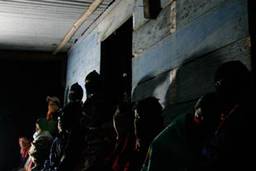Militarizing Mexico’s Drug War
More than 1,000 police officers, soldiers and members of enemy cartels have been killed this year as President Calderon has turned up the heat
John Gibler

“In the helicopter is where they began to beat us,” recalls Sara, a 17-year-old who was released on May 16 after a week in military detention. (Her name has been changed to protect her identity.)
“They threw me really hard into the helicopter,” she says. “They kicked me all over my body. Then one got on top of me; I could hear the other girls screaming. The soldiers said that this would take the whore out of us, that we were going to hell, that they were the law.”
Seven months ago, President Felipe Calderón of the conservative National Action Party took office and declared war on drug traffickers, ordering 20,000 troops into the streets to put an end to drug-cartel related murders. Despite the troops, the number of drug-related murders has tripled and the army’s massive deployment has yielded tales of widespread human rights violations, like that of Sara.
More than 1,000 people, mostly police officers, soldiers and members of enemy cartels, have been killed since Jan. 1. In Veracruz, elite armed gangs linked to the Gulf Cartel planted a decapitated head outside an army barracks with a note: “We’re going to keep going when the federal forces get here.” In Tabasco, men in a Jeep Cherokee delivered a refrigerator to the front door of the newspaper Tabasco Hoy; inside security agents found the severed head of a city councilman.
Drug trafficking across the Mexico-United States border exploded in the ’80s in the wake of U.S. moves to quash traffickers from Colombia and the Caribbean. Since the ’90s, drug traffickers have moved an estimated $10 billion worth of cocaine, marijuana, heroin and methamphetamines across the border each year. As much as 70 percent of the cocaine that enters the United States crosses the border from Mexico. Drug-related violence between warring cartels has plagued the borderlands for years, increasing in the ’90s and then exploding in the last two years.
Three thousand people died of drug-related violence during the six-year reign of former President Vicente Fox. Last year, more than 20 police officers and rival gang members were beheaded, and their heads were often put on public display in harrowing fashion. In Acapulco, two police officers’ heads were posted on the fence outside a state government building above a poster-board sign that read: “So that you learn some respect.” In Michoacán, assassins stepped into a crowded nightclub and rolled five severed heads onto the dance floor.
The army roundup that detained Sara M. started with a shoot out on May 1 between soldiers and members of a cartel gang, who were driving down the only paved road in Carácuaro, Michoacán. When a group of soldiers in civilian clothes apparently backed into the gang members’ truck, a minor fender bender erupted into a fierce 20-minute gun battle. Locals ran for cover and the town police stayed indoors, thinking that the gunfight was between two rival gangs. Five soldiers, including a colonel, died and three more were wounded. The gang members escaped, leaving behind one dead.
Within hours, the army mobilized more than 1,000 soldiers to comb the Tierra Caliente region of Michoacán and look for the gang members. The army raided houses in Carácuaro, neighboring Nocupétaro, and surrounding villages. Soldiers beat, detained and tortured dozens of farmers who had the misfortune of sharing the same last name as the dead gang member. Mexico’s National Human Rights Commission gathered more than 50 complaints of human-rights violations during the army’s operation around Carácuaro.
Soldiers took Sara, a 17-year-old friend and 32-year-old Carmela Martínez from Martínez’s house. Soldiers also detained two waitresses, ages 16 and 17, from a nearby restaurant owned by Martínez. They were all hooded, with their hands tied behind their backs, on the floor of the military helicopter when the soldiers began to undress them.
“They kicked me, they bound my hands so tight that my blood could barely circulate. That day a friend and me were wearing miniskirts, and they raised them up, they lowered our underwear and they were touching us,” Sara says.
Two of the girls told members of the Human Rights Commission that during the helicopter ride, after being threatened, beaten and molested, the soldiers placed warm rags over their mouths that caused them to lose consciousness. One girl awoke with vaginal pain and bleeding.
Police with close connections to the army said that Sara and her friends were “connected to the Zetas,” a gang connected to the Gulf Cartel. One police official told the Mexican national newspaper, El Milenio: “No, look, these girls even have kids and like to party. I don’t think the soldiers raped them; I’m sure they just grabbed them in a few places, just a couple of touches here and there, but no rape, they were even ugly.”
Sara says she didn’t know anything about the Zetas and the recent clash between soldiers and a drug gang. She had just come to visit from Cuernavaca and was set to leave the next day.
Now, Sara does not know where to go. Her husband sounds distant on the phone, she says, and she doesn’t know if he will allow her to go back home. Moreover, one thing the soldiers told her has consistently haunted her: “They said that if the Zetas don’t kill me then they will.”
On May 23, the Mexican Congress passed a resolution urging Calderón to professionalize and train the federal police forces so as to avoid using the army to fight drug traffickers. The resolution noted that the army’s involvement has “taken on a Messianic dimension.” But the following day Calderón said he had no intention of backing down.
Neither do the cartels. The following weekend, drug-related assassins killed 20 people in eight different states across the country.









